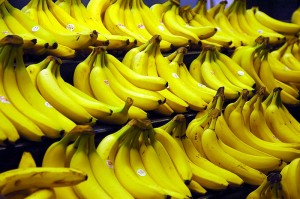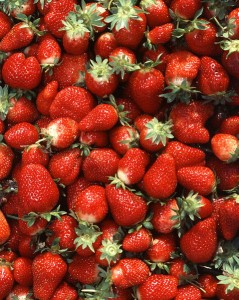Guest post by Pinchnickel
PHOENIX, Ariz. – Save big bucks by playing the commodities future market at your grocery store every week. Buy in season, freeze, preserve, and consume later when prices double. Save even more when you factor in clipped discount coupons.

Let’s go shopping. Today’s futures bargain is bananas. Late spring is harvest season in tropical Central America, home of those shoot-em-up banana republics. “America’s favorite fruit” has become a “price-fixed” commodity, meaning all local grocers charge the same price [currently in the Southwest about 69 cents a pound]. But grocers in your area may break from the price-fixing mold and list bananas as a seasonal loss leader. For example, a Phoenix grocery chain currently offers four pounds for 99 cents, or 25 cents a pound.
Bananas spoil quickly, but I’ll preserve the nutrients of that banana bargain by converting them into low-sugar banana bread and muffins stored in my chest freezer for future consumption.

Strawberries currently are arriving here by the truckload from California, as they do every year, and are now available for $4 a 4-pound container, or a buck a pound. To bank strawberries seal in a zip-bag and freeze for up to a year. I mix them with rhubarb for pies, but they can also be turned into toppings for shortcake or ice cream.
Spring is also the time when veggies grown in warmer zones like Mexico arrive at your grocers. They include asparagus, broccoli, spinach, carrots, cilantro. Preserve by blanching in boiling water  and freezing for future use. Turn the cilantro into pesto—delicious spread on toast.
and freezing for future use. Turn the cilantro into pesto—delicious spread on toast.
At other times of the year lower-priced pork, beef and even fish will arrive in your local grocery at seasonal prices. Fruits such as apples, peaches and pears arrive in late summer. Learn how to preserve them in syrup or as jams and jellies. Canning supply companies Ball and Kerr both offer recipe books by mail.

The very best “loss leader” season across this land, of course, occurs in early to late autumn, when the great American harvest begins everywhere. Leading the list of good buys then: white flour, beet sugar, potatoes, berries, apples, corn. Because I produce all my own baked goods, autumn is when I put in 100 pounds of flour and 30 pounds of sugar for use throughout the year, when a glut of flour and sugar hit the market for only 99 cents a pound. The same flour and sugar costs $2-plus later in the year—a 50 percent return on my commodities future buy.
If you’re a joyfully consuming foodie or simply a Pinchnickel like me, acquaint yourself with the harvests and when imported products arrive at your grocer, and buy ahead of need. Keep your freezer full of these wonderful bargains. Save big, and enjoy those buck-a-pound strawberries over shortcake next January when your friends are paying $3 a pound for them.
Images:
Bananas: Steve Hopson, Creative Commons Attribution-Share Alike 2.5 Generic license, Wikipedia
Strawberries, Ken Hammond, U.S. Agricultural Research Service, public domain
Asparagus: RyanFreisling, public domain
Flour, R.Wampers, Creative Commons Attribution-Share Alike 2.0 Belgium license, Wikimedia Commons

I first read about this idea in Andrew Tobias’s book–The Only Investment Guide You’ll Ever Need. He talked about it on those exact terms and mentioned that he had a case of tuna under his bed. i was in grad school at the time and this was an idea I could implement.
I am too lazy to freeze and can, so I mostly do this w/ the few canned foods I buy–tomatoes, e.g. As a tip, I would add that you can get frozen fruit for $1.00 at Dollar Tree–12 oz to 1 lb.
btw, I sent you a short post via a hotmail acct. Did you get it?
This is a truly fantastic post. I’m getting all excited about it. Unlike frugal scholar, I’d never heard of this on a broad scale but have been considering doing something similar when those green beans hit the farmer’s market this summer. I love beans! and there’s this expression in french , “C’est la fin des harricots” (it’s the end of the beans literally) which means it’s all over!
But I was scheming about having beans all year. I like your idea of waiting around for great prices on flour too as I do all the shopping.
Also, sometimes I just freeze bananas whole if I don’t have time to make bread and then thaw them (on a plate). Once they’re thaw I squeeze the liquid banana into my mixing bowl for banana bread.
Besides being cheaper, I always find in-season foods to have more flavour. Great post.
I do the same thing. I really utilize my freezer to stock up on fresh fruits and veggies in season and then eat all year. It saves so much money.